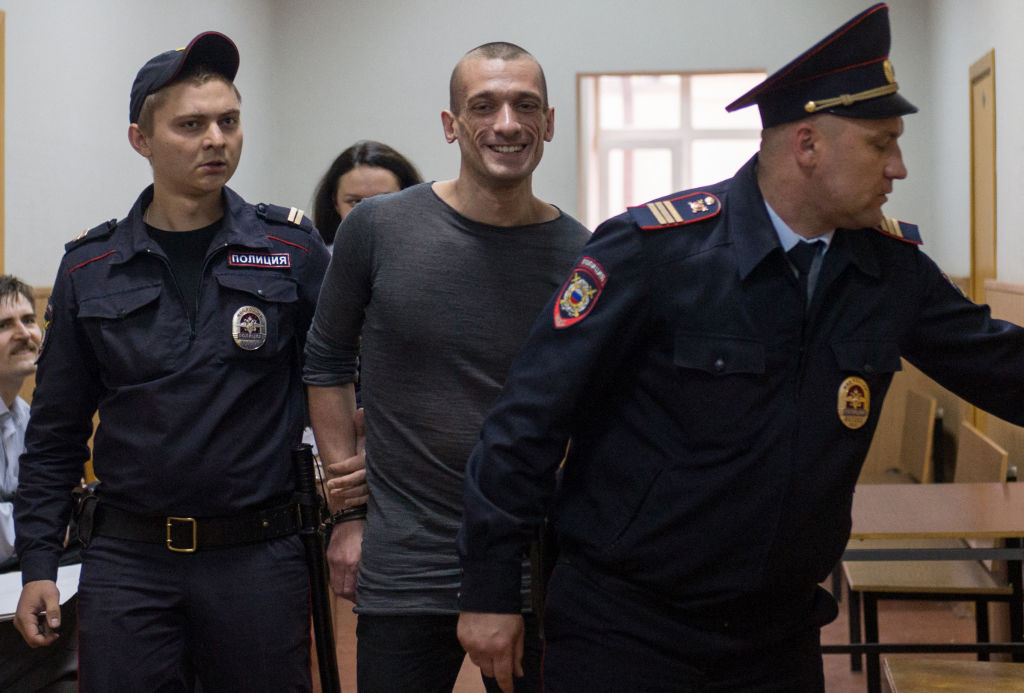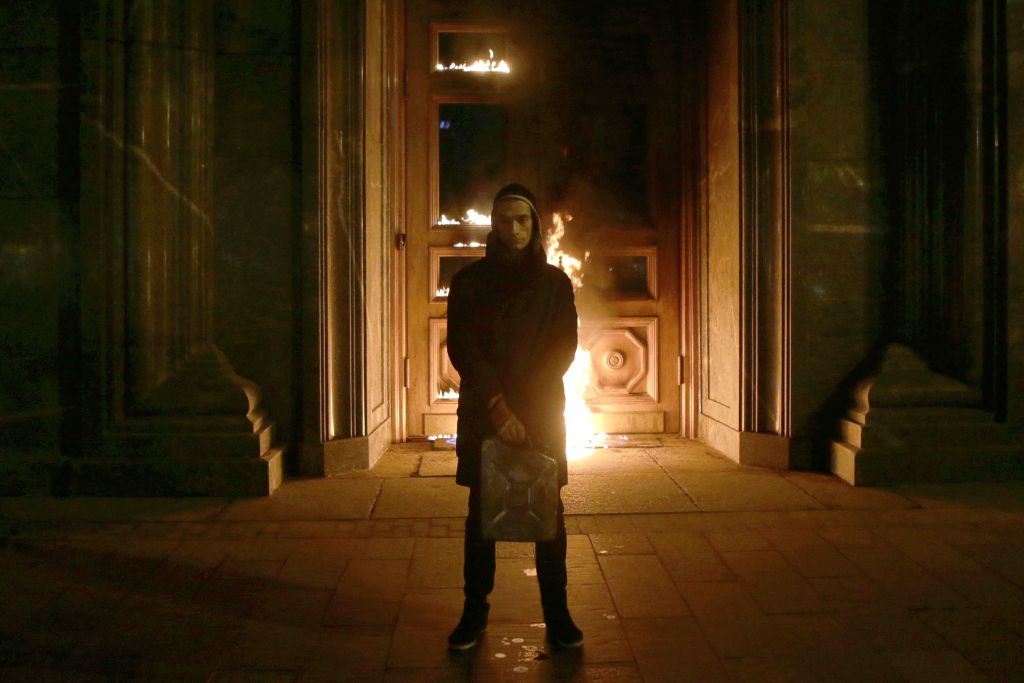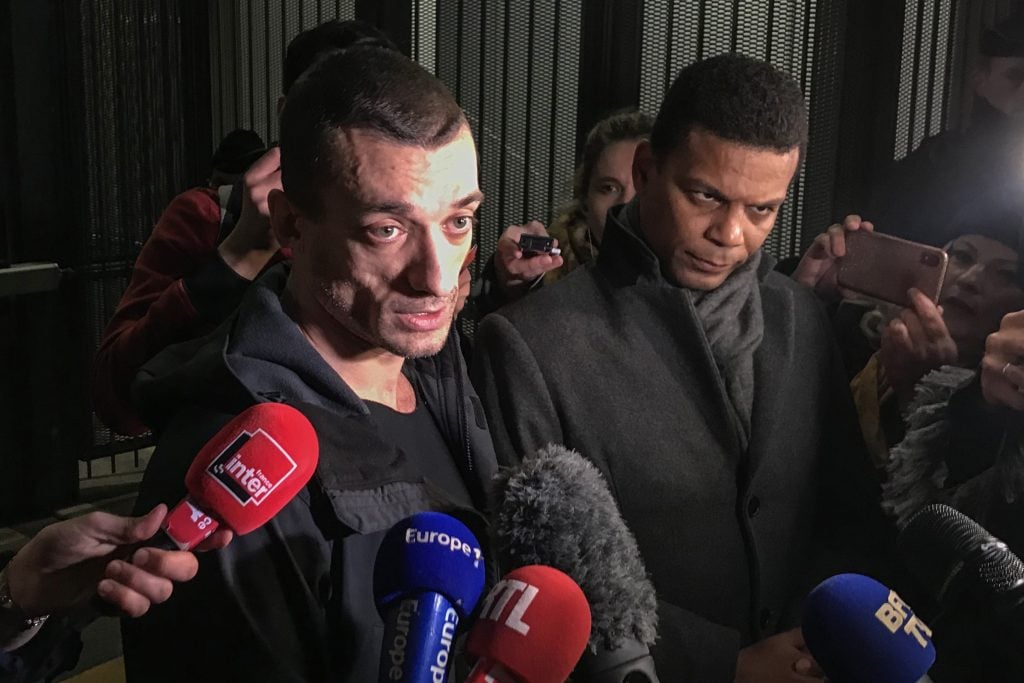The public prosecutor’s office in Paris has called for the Russian artist Pyotr Pavlensky to be handed down a six-month prison sentence and a fine of €50,000 ($54,000) for having recorded and diffused sexual images of the former French politician Benjamin Griveaux without his consent.
At the closing of the trial at the Renzo Piano-designed Tribunal de Paris on Wednesday, June 28, the public prosecutor also asked for Alexandra de Taddeo, Pavlensky’s girlfriend with whom Griveaux had an extramarital fling, to receive a six-month suspended sentence. The verdict is expected on October 11, 2023.
Pavlesnky, who was born in Saint Petersburg, is known for his controversial performances that he calls “events of Subject-Object Art.” Some works have incorporated an aspect of self-harm, such as sewing his lips together, and the message is often targeted at powers that be or politicians. Pavlensky is based in France, where he sought asylum after fleeing sexual assault charges Russia in 2017.
Pavlensky and de Taddeo were accused in the Paris trial, attended by Artnet News, of having leaked videos showing Griveaux’s genitals. Pavlensky posted footage of the politician sending intimate messages to a young woman and a video of him masturbating onto his website, Pornopolitique (Pornopolitics), when Griveaux was running to be mayor of Paris in 2020.
Following the controversy, Griveaux ended his mayoral campaign as the candidate of French president Emmanuel Macron’s party, La République en Marche. Griveaux had served as spokesman in the government of former French Prime Minister Édouard Philippe during Macron’s first presidential term.
Griveaux was absent from the trial where he was represented by his barrister, Richard Malka.

Russian performance artist Pyotr Pavlensky (center) is escorted inside a court building before a hearing in Moscow on May 18, 2016. He faced up to three years in prison for dousing the door of the FSB building, the successor to the KGB, with gasoline and setting it on fire in November 2015 in a performance he called “Threat.” Photo by Alexander Utkin/AFP via Getty Images
Pavlensky, 39, and de Taddeo, 32, arrived one hour late, holding hands. Clasping her recently published book L’Amour, which chronicles her sexual relationships, de Taddeo was wearing a silvery pale sequined dress and Pavlensky was clad in a black T-shirt and jeans.
While the presiding magistrate was stating the couple’s identity, the performance artist proclaimed: “Today will be the judgement of the eighth event of Subject-Object Art, the porno-political event; I’ll be judged for combining high and low style.” (By this, it is thought, based on previous media reports, that “high” referred to a politician’s portrait whereas “low” referred to genitalia.) Pavlensky’s outburst and the ensuing applause from supporters prompted the judge to briefly suspend the hearing.
Talking to journalists outside the courtroom after the pause in proceedings, Pavlensky said: “An artist should always make an introduction. The judge started to annoy me and wouldn’t let me speak. So after that, why should I talk to the judge who doesn’t respect my word?” When the trial resumed, Pavlensky invoked his right to silence during the proceeding.
The artist had previously spoken of Griveaux’s “political hypocrisy,” saying that it prompted him to launch his Pornopolitique website which he “envisaged as the world’s first porn website to involve politicians or elected and appointed government officials.” De Taddeo, a student, founded an association to finance the website. She claimed to have no creative role, merely a financial and organizational one.
Pavlensky’s lawyers, Yassine Bouzrou and Anna Branellec, called several witnesses to speak in his defence. The first witness present was Jenny Doussan, a lecturer in visual culture at Goldsmiths University of London. Doussan had contributed an essay to Pavlensky’s book Pornopolitics and Other Precedents, published in conjunction with his solo exhibition at the art space a/political in London last year. As Doussan does not speak French and no translator was present, she was unable to give testimony. Instead, extracts from Dussan’s submitted document were read aloud to the court.
Three further witnesses were actors who recited passages from the 17th-century satirical play Tartuffe ou I’lmposteur about religious hypocrisy by the French playwright Molière. After Pavlensky and someone in the public gallery clapped after the first actor’s recitation, the judge ordered another break in proceedings. “Know that this isn’t a spectacle but a trial,” she said.
The American art historian and curator Carrie Pilto also took to the stand. Pilto has included Pavlensky’s work, Lighting (2017), a video showing the artist being arrested after setting fire to the facade of the Banque de France in Bastille, Paris, in the current group exhibition, “Someone is Getting Rich,” at Amsterdam’s Tropenmuseum, which she has curated.

Russian artist Pyotr Pavlensky poses after setting fire to the doors of the headquarters of the FSB security service, the successor to the KGB, in central Moscow early on November 9, 2015. Photo by Nigina Beroeva/AFP via Getty Images
Pilto told the court that “questioning normative codes is one of the strengths of contemporary art” and quoted Pavlensky’s views on the “puritanism and hypocrisy of male politicians.” Asked by Bouzrou, one of Pavlensky’s lawyers, if the Pornopolitique website fell within the continuum of Pavlensky’s body of work, she replied: “Absolutely. He creates artworks to question the state.”
Freedom of expression versus the right to privacy has been central to the case. Malka advocated that de Taddeo and Pavlensky had deprived Griveaux of his right to a private life by diffusing sexual images without his consent. “Politicians also have the right to a private life,” said Malka. Earlier, Malka’s fellow barrister alleged that there was a string of “coincidences” in how the images from de Taddeo’s computer had “miraculously” come into Pavlensky’s possession.
In his summing up, Malka said to Pavlensky and de Taddeo: “You are the Bonnie and Clyde of the bedroom.” He accused the couple of thinking of themselves for “a quarter of an hour of celebrity” and Pavlensky of “pathological narcissism.” Malka said: “Art is an instrument for elevating, not a tool for sadism or reality TV.” Malka told the courtroom: “You [the public gallery] would also become the object of an artwork,” in allusion to Pavlensky’s statement about Subject-Object Art. At the end of Malka’s conclusions, Pavlensky retorted: “You’re a big imbecile.”
The public prosecutor’s office said there was a “clandestine nature” in how de Taddeo had saved the images sent by Griveaux on her computer and USB key without his knowledge. It argued that their diffusion constituted a “disproportionate” use of the limits to freedom of expression and “publication of sensationalism.”
However, de Taddeo’s lawyer claimed making screenshots of images had become normal to justify how the images, intended for “ephemeral” use, had become “permanent.” She said that her client was unaware of Pavlensky downloading them from her computer.
The last barrister to speak was Bouzrou. “Everything has been done to bring down Petr Pavlensky,” he said. Bouzrou contended that the leaked sex videos were “a contribution to the general interest” in Griveaux as a mayoral candidate who had spoken about his family life.
More Trending Stories:
A 17th-Century Double Portrait of Black and White Women, Said to Be of ‘Outstanding Significance’ Will Remain in the U.K.
Barbie’s Real-Life Hot Pink Malibu Dreamhouse, Complete With Ocean Views and a Roller Rink, Is Available to Rent on Airbnb
A Frank Frazetta Painting of a Brawny Warrior Sold for $6 Million, Making It the World’s Highest-Priced Work of Comic Book or Fantasy Art Ever
A German Museum Came Up With an Insanely Low-Tech Solution to Protect Its Rembrandt Canvas From a Leaky Ceiling
A U.S. Judge Permanently Banned Digital Artist Mason Rothschild From Selling His ‘MetaBirkin’ NFTs, Handing a Win to Hermès
This Famed Dollhouse Is Hung With Tiny Original Artworks, Including a Miniature Duchamp. Here Are Three Things to Know About the One-of-a-Kind Treasure
Elisabetta Sirani Painted in Public to Prove Her Work Was Her Own. Here’s How She Became a 17th-Century Star—and Why She’s Being Remembered Now









